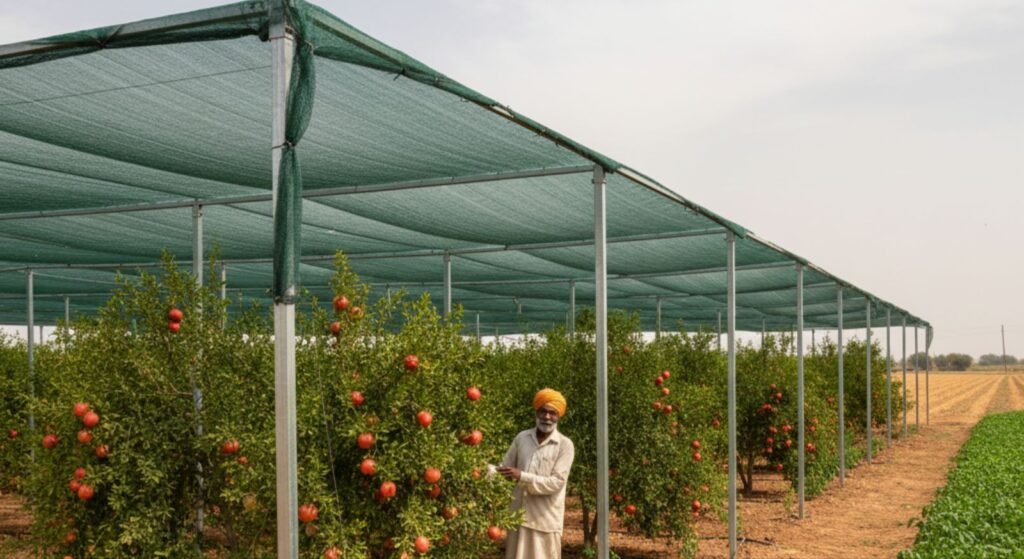Introduction
Rajasthan is known for its extreme weather. Scorching summers, dry winds, and unpredictable rainfall make farming a challenge. Farmers here constantly battle against high temperatures and water scarcity. In such conditions, traditional open-field farming often leads to crop losses or reduced yields.
This case study highlights how a farmer in Rajasthan adopted a flat roof shade net house, and how it transformed his orchard and vegetable farming practices.
The Farmer’s Challenge
Mr. Singh (name changed for privacy), a mid-scale farmer in Ajmer district, primarily grew pomegranate and seasonal vegetables like tomatoes and chilies. However, his crops suffered year after year:
- Summer Heat Stress: Plants often dried out or showed leaf burn during May–June.
- High Evaporation Losses: Water scarcity was worsened by high evapotranspiration rates.
- Pest Pressure: Open fields exposed his crops to insect attacks and bird damage.
He realized that without some kind of protective structure, continuing farming would be financially unsustainable.
The Solution: Flat Roof Shade Net House
In 2021, with support from a horticulture subsidy, Mr. Singh installed a flat roof shade net house across one acre. The shade net (50% density) was selected to cut down solar radiation while still allowing enough light for photosynthesis.
The design was simple yet effective:
- Flat Roof Structure suitable for Rajasthan’s dry climate.
- HDPE Shade Nets with UV stabilization to withstand high sun exposure.
- Drip Irrigation installed underneath to maximize water efficiency.
Results Observed
Within the first two seasons, the farmer noticed visible improvements:
- Better Survival of Fruit Trees
Young pomegranate trees, which earlier struggled in summer heat, showed healthier foliage and stronger growth under the net house. - Reduced Water Usage
Evaporation was cut by nearly 25–30%. This was crucial in a region where water availability is limited. - Improved Vegetable Yields
Tomato and chili crops gave nearly 20–25% higher yields compared to open-field cultivation. Fruits were less sunburnt, and overall quality improved. - Lower Pest Incidence
Shade nets acted as a partial barrier against birds and large insects, reducing losses.
Financial Impact
While the initial investment was around ₹3.5 lakhs (for one acre), with subsidy support, Mr. Singh recovered most of the cost within two years. The higher yields, better fruit quality, and water savings ensured that his farm turned profitable faster than expected.
Key Learnings
- Shade nets are a cost-effective solution for semi-arid regions like Rajasthan.
- They provide just enough protection to fruit trees and vegetables without requiring the heavy investment of a polyhouse.
- Combining shade nets with drip irrigation offers maximum results in water-scarce zones.
Conclusion
This case study shows that even in extreme climates like Rajasthan, affordable technologies such as flat roof shade net houses can make farming more sustainable and profitable. Farmers who cannot afford high-end polyhouses can still benefit greatly from shade nets, especially when combined with smart water management practices.
FAQs
Flat roof shade nets are simple, low-cost structures that reduce heat stress and water loss. They are ideal for Rajasthan’s dry climate where affordability and durability are key.
Depending on the crop, farmers typically see 15–30% higher yields along with better fruit and vegetable quality.
Yes, under the National Horticulture Mission (NHM) and state schemes, farmers in Rajasthan can receive subsidies covering 40%–60% of the project cost.

